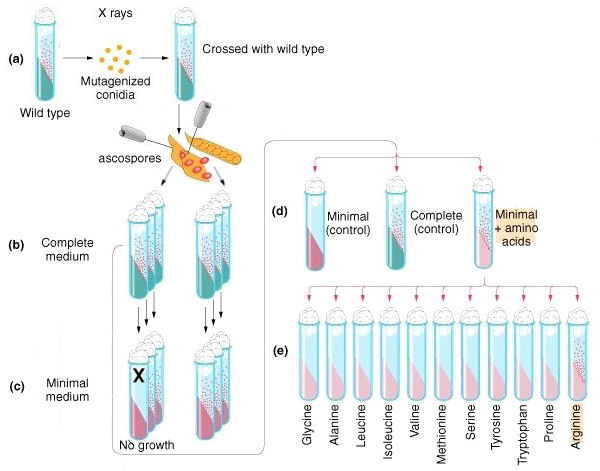
The Beadle - Tatum experiment:
Identification & characterization of nutritional mutants of Neurospora
(a) Wild-type Neurospora fungi
are
able to grow on minimal medium
(a carbon source
and inorganic salts only). Individual conidia (asexual, haploid spores) are exposed
to X-rays, which are mutagenic.
The mutagenized spores are grown on complete medium (minimal medium plus a full range of amino acids), and are
crossed with non-mutagenized wild-type Neurospora. The diploid offspring
produce haploid ascospores, which are
dissected with needles, and transferred individually to new
tubes with complete medium.
(b) The haploid spores grow asexually as haploid fungi.
(c) Individual pores from each of the haploid fungal cultures are tested for ability to grow on minimal medium. Most grow, some do not. Inability to grow (as in culture X) indicates that a genetic mutation that affects the ability to produce some critical growth substance was induced in the parent spore by the X-rays.
(d) Returning to the culture in part (b) that showed a "no growth" phenotype in part (c), individual haploid spores are again grown on minimal and complete media as controls. They are also grown on experimental media, which are a series of minimal media supplemented with one specific amino acid, as shown in (e).
(e) Spores from each culture grow on one and only one of the supplemented media. In the example, growth on minimal medium + arginine indicates that the mutation altered the ability of the particular fungal culture to synthesize arginine. The strain is designated arg- [read, 'arg minus'] to indicate a defect of arginine synthesis.
Beadle and Tatum repeated this experiment for hundreds of mutagenized Neurospora, and obtained scores of nutritional mutants that were unable to grow on minimal media, without the addition of specific amino acids. They concluded that the genetic mutations had each altered the ability of a specific gene to synthesize a specific amino acid. Evidently, one gene was responsible for one enzymatic synthesis: "One Gene: One Enzyme." This conclusion preceded any knowledge of the biochemical nature of genes themselves.
Homework: The test in (d) includes minimal and complete media growth experiments as "controls": what do these experiments "control" for? Hint: If growth occurred on both minimal and complete medium: what would you conclude?
(b) The haploid spores grow asexually as haploid fungi.
(c) Individual pores from each of the haploid fungal cultures are tested for ability to grow on minimal medium. Most grow, some do not. Inability to grow (as in culture X) indicates that a genetic mutation that affects the ability to produce some critical growth substance was induced in the parent spore by the X-rays.
(d) Returning to the culture in part (b) that showed a "no growth" phenotype in part (c), individual haploid spores are again grown on minimal and complete media as controls. They are also grown on experimental media, which are a series of minimal media supplemented with one specific amino acid, as shown in (e).
(e) Spores from each culture grow on one and only one of the supplemented media. In the example, growth on minimal medium + arginine indicates that the mutation altered the ability of the particular fungal culture to synthesize arginine. The strain is designated arg- [read, 'arg minus'] to indicate a defect of arginine synthesis.
Beadle and Tatum repeated this experiment for hundreds of mutagenized Neurospora, and obtained scores of nutritional mutants that were unable to grow on minimal media, without the addition of specific amino acids. They concluded that the genetic mutations had each altered the ability of a specific gene to synthesize a specific amino acid. Evidently, one gene was responsible for one enzymatic synthesis: "One Gene: One Enzyme." This conclusion preceded any knowledge of the biochemical nature of genes themselves.
Homework: The test in (d) includes minimal and complete media growth experiments as "controls": what do these experiments "control" for? Hint: If growth occurred on both minimal and complete medium: what would you conclude?
Figure © 2000 by Griffiths et al. ; text © 2024 by Steven M. Carr